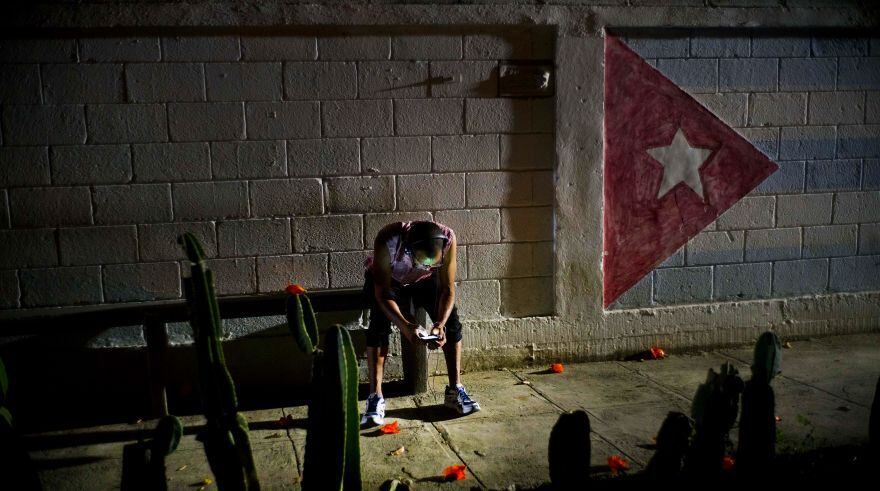
Power cuts, one of the factors that fueled social discontent last year in Cubaare repeated on the island in the run-up to the warmest months of the year, those with the greatest demand.
Experts consulted by Efe consider that this issue, along with other causes behind the anti-government demonstrations on July 11, 2021, remains unresolved and is a political risk factor.
Last Wednesday they were planned “interruptions” in 10 of the 15 municipalities of Havanaaccording to the electricity company of the capital, scheduled between 8:00 and 16:00 local time.
The situation is not new. In the last 11 months, the Electrical Union (UNE) It has notified more than 300 damages, due to breakdowns or maintenance tasks, in many of the 13 Cuban thermoelectric plants (eight on land and five floating).
The problems are mainly due to the fact that the production system is at the limit of its useful life and without maintenance due to the country’s economic problems as a result of US sanctions and failures in national management.
In mid-March, for example, the western Antonio Guiteras plant, the country’s largest thermoelectric plant, was out of service due to a boiler failure a week after a planned maintenance shutdown.
That same plant failed again “unforeseen” on April 16, and resumed operation five days later.
In those days in the province of killings and neighboring regions, three-hour rolling blackouts were scheduled for several days in a row. In adjacent Havana there were cuts for “maintenance” in six of its fifteen municipalities.
The UNE also reported at least seven more plants that were temporarily out of service during the past month, some of which were scheduled to be reviewed for the summer season, with greater energy demand due to the use of air conditioners.
The spark of discomfort
Experts point out that the cuts in supply were one of the reasons that led Cubans to protest in the anti-government marches last July, along with the health crisis due to the COVID-19 and the shortage of basic products, such as food and medicine.
In fact, the July 11 protests began in Santiago de los Baños (west) during a blackout.
The Cuban sociologist Goddess Ortegadirector of the School of Sociology of the Chilean Silva Henriquez Catholic University and born in that locality, was convinced of the “impact” they have blackouts in discontent.
“When there is a power outage, life is doomed to come to a standstill”Ortega explained and added that this “forced shutdown” negatively affects “the experience” Y “within expectations” from the people.
For Ted Henkenuniversity professor at Baruch College from New York and expert on Cuba, the lack of solutions to this and other key problems in the socio-economic sphere for Cubans fuels discontent.
“The basis of the complaints has not been resolved, in my opinion, at all. It is possible, even probable, that there may be new protests.plot.
Michael J Bustamanteassociate professor of history University of Miamiadds that, unlike last year, when the island was closed due to sanitary restrictions, the discomfort is currently being reflected in migration.
“There is discontent, when we analyze it in general, migration changes the dynamic in some way”adds Bustamante, who also describes the exodus of recent months as a “scape valve”.
According to US immigration authorities, some 47,331 Cuban migrants entered the United States between October and February, after a record number of 16,657 arrived at the border in February alone.
Bustamente believes that the situation “it’s worse than a year ago” on issues such as shortages and energy poverty, but – like Henken – points out that other factors, such as control of the pandemic, have partially appeased social irritation.
Solutions to avoid outages
Cuba relies heavily on foreign oil to produce energy (thermoelectric plants generate two-thirds of electricity) and its main supplier, Venezuelahas significantly decreased its shipments.
The Cuban government aspires to reduce this dependency and has a plan so that in 2030 37% of its energy mix (just over 3,500 megawatts) comes from renewable sources.
The repercussions of the thermoelectric stoppages are not limited to blackouts. When Antonio Guiteras was damaged in March, in Havana and other adjoining municipalities began to see long queues to load gasoline. Soon the situation affected public transport.
the state company Cuba-Petroleum Union (CUPET) explained that the shortage was related to an increase in demand after cuts in supply and the consequent use of generating plants.
Since 2021, the island has used five floating plants leased from a Turkish company to support the antiquated electricity production system.
Bustamente believes that the arrival of the floating plants -two of them in recent months- is a sign that the “The government is aware that (electricity) is a very big concern of the population and a source of much discomfort”.
Source: Gestion
Ricardo is a renowned author and journalist, known for his exceptional writing on top-news stories. He currently works as a writer at the 247 News Agency, where he is known for his ability to deliver breaking news and insightful analysis on the most pressing issues of the day.












